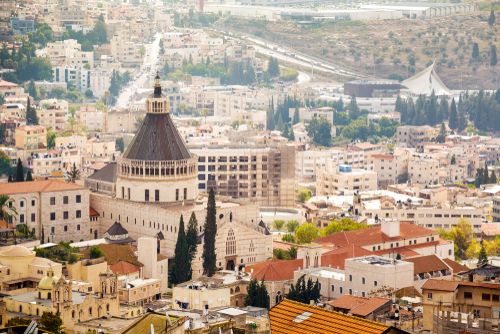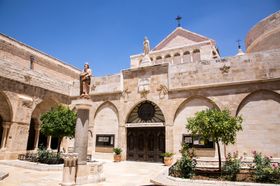Nazareth: The Significance in Jesus’ Time
Published April 28, 2025

Located in the lower part of Galilee, a district in the north of Israel, 56 km west of the sea of Galilee, set in a small basin, lies the ancient city of Nazareth. While being one of the smallest cities on earth, this town is filled with cultural diversity and sites of religious significance. The origin of the city itself is believed to date back 4221 years, all the way back to approximately 2200BC when Nazareth was just a trivial, little peasant village that is overlooked by mountains on all sides.
What Happened in Nazareth
Nazareth did, however, not become culturally important until around the year 5BC when a young girl met an angel of God called Gabriel who gave her news that she will be falling pregnant with Jesus our Lord. The girl was Mary of Nazareth, who was to be engaged to Joseph.
After fleeing from the wrath of Herod, Joseph and Mary stayed in Egypt until the time Herod passed away, after which they then returned to Nazareth to raise their boy Jesus as a Nazarene in the Jewish culture.
Why Nazareth? Why was it so important that Jesus had to grow up in Nazareth specifically? Why did they not stay in Egypt?
Let us rewind the story a little bit.
In the years leading up to the actual creation of the village, some six centuries before people settled there, the prophet Isaiah prophesied that the Messiah would come from a town called Nazareth. This peasant village sitting in the middle of nowhere had to become the birthplace of Christianity. What were the odds of this coming to pass? Astronomical to say the least, and yet today we know this to have come to pass. (Matthew 2:22-23)
Life and Food in Nazareth 6BC
Home to Farmers and Tradesmen
In the time that Jesus called Nazareth home, it was home to less than 300 Jews living simplistic lives as farmers and tradesmen in Galilee. They were mostly livestock farmers, herding sheep, goats, cattle, chickens, mules as well donkeys, and camels. Some sources even indicate that domesticated animals, such as cats and dogs were also kept.
The Housing
Houses in ancient Nazareth were built with stone foundations and bricks made from mud. Archaeologists speculate that some of the wood might have been used in the structure of the roofs, but not anywhere else since wood would have cost very expensive. The houses in Nazareth are most likely simple and small.
Staple Food of Nazareth
Food in ancient Nazareth was like the basic staples we have today, except, of course, a lot of work went into the cooking and preparation of thereof. All food processing had to be done by hand, the milling of grains and chopping of firewood for baking bread.
The average meal for a Nazarene was plain and wholesome. The bread was a staple of every meal, and women made it as often as needed. During warmer summer months, they probably baked several days worth of bread ahead of time to store for meals to come. In the evenings, they would consume their main meals. It might have consisted of a lentil stew seasoned with herbs like cumin or coriander.
Nazarenes had access to milk from their livestock and undoubtedly made their cheese, which would have been a good source of protein other than meat. Furthermore, vegetables like olives and onions were readily available. Options like water, wine or curdled milk would have been on the menu to drink. There would also have been fresh and dried fruit.
An Ancient Self-Sustainable Village
Like any self-sustaining village from the ancient world, there were also jobs such as blacksmiths, carpenters, farmers, and builders. The Bible tells us that Joseph, the husband of Mary, was a carpenter by trade. It is assumed that Jesus would have been trained by Joseph in this trade, as it is Jewish culture that the eldest son to follow in the footsteps of his father.
Jesus grew up in this small community of Nazareth, applying his trade until he was around thirty years old. During this time, he might have had to look after his family after Joseph passed away. Jesus was a well-known person by everyone in Nazareth. Not only due to the size of Nazareth but because Jesus also showed a keen interest in teaching his fellow Nazarenes about God, the laws of God as well as the prophecies of the prophets.
The Ministry of Jesus, the Nazarene
Around the age of thirty years old, Jesus started his ministry and relocated to Capernaum, which was located east of Nazareth, on the banks of the sea of Galilee. Throughout His ministry, His reputation went before Him. So much so that when people spoke of The Nazarene, they meant Jesus. Even the disciples of Jesus were being called Nazarenes, although none of them even originated from there.
Nazareth had received the status of the village where Jesus was from. Sadly, enough when Jesus returned to Nazareth, He was being rebuked for saying that He is the Messiah. So much so that the Jewish elders, knowing all too well who he was, wanted to murder him by throwing him off a cliff. Jesus concluded, "Truly I tell you no prophet is accepted in his hometown" (Luke 4:24).
Nazareth is a small town that only became important after Jesus put it on the map. This peasant town is diverse and interesting with a unique history, fulfilling prophecies and giving the world the Messiah who came to save the people.







